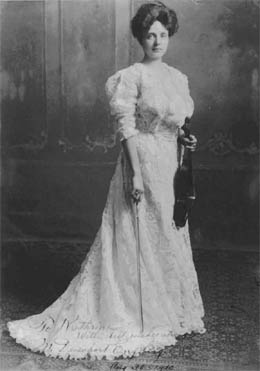On April 24, 1921, a new conductor, Mary Davenport-Engberg (1881-1951), debuts the Seattle Civic Symphony Orchestra in concert at Seattle's Metropolitan Theatre. After experiencing financial ups and downs since its founding in 1903, the Seattle Symphony has faltered in the early 1920s and Engberg -- a virtuoso violinist widely said to be the only woman conductor of a symphony in the nation -- steps up to help fill the town’s cultural void. The Post-Intelligencer praises the afternoon performance, noting that the 90-member ensemble displays a "surprisingly high level of excellence."
A Homegrown Talent
Mary Cornwall was born in a covered wagon en route from California to Washington in 1881. Her parents, the Reverend John Cornwall and his wife, chose to settle their family near Spokane. While still a young girl, Mary’s mother died and she was adopted by a local family, the Davenports of Mount Hope, Washington. In 1890, they relocated to Bellingham and in 1898 Mary was wed to Henry Christian Engberg.
The young couple moved to Europe, where Davenport-Engberg studied music in both Germany and Copenhagen and where she made her concert debut as a violinist in 1903. By 1912, she was back home working as a teacher at Bellingham’s State Normal School, and by 1914 she had organized and begun serving as conductor for the Bellingham Symphony Orchestra.
The Seattle Civic Symphony Orchestra, 1921-1924
In 1920, the Davenport-Engbergs moved south to Seattle so Mary could expand her musical horizon. The Seattle Symphony Orchestra, which had been plagued with organizational and financial problems, had performed only sporadically for the past several years, under the baton of John Spargur. It did have a successful season in 1919, but its finances did not improve, and it suspended operations after the 1920-1921 season.
This presented a challenge and an opportunity for a musician of Davenport-Engberg's caliber, and she stepped into the breach. In the spring of 1921 she recruited both professional and amateur musicians, formed a group of approximately 90 players, and opened the 1921-1922 season of what was called the "Seattle Civic Symphony Orchestra" at the city's Metropolitan Theatre.
Under her leadership this was to be the city's symphony orchestra for the next three years, and its performances were welcomed by a town that at the time had no other. Its concerts received enthusiastic notices, and many musicians believed it to be the most accomplished orchestra the city had yet seen. The Seattle Civic Symphony Orchestra would play for the three years, with Davenport-Engberg ending the final season, and her leadership, in a May 4, 1924, performance. There followed another hiatus, this one lasting two years, until the organization came together again, under the leadership of Karl Krueger and using the name "Seattle Symphony Orchestra."
Historical Questions
The fragmented history of Seattle's symphony orchestra during these years has led to considerable disagreement about Davenport-Engberg's right to be included in an accounting of its leaders. The local newspapers of the day did not help matters by referring to the orchestra she conducted as both Seattle Civic Symphony Orchestra and the Seattle Symphony Orchestra.
Some sources maintain that Davenport-Engberg's Seattle Civic Symphony Orchestra was an entirely different organization from the Seattle Symphony Orchestra, the name that was used both before and after her tenure. Others maintain that, as the only symphony orchestra in Seattle during that time, her group is properly counted in the symphony's line of succession, and she properly is included in any list of the orchestra's leaders.
Ninety years later (as of 2012) and hampered by the orchestra's tangled early history, the debate does not seem to lend itself to resolution through any citation to specific facts. The divergent positions hinge primarily on whether or not one believes that Seattle's symphony orchestra, despite brief periods of not performing, has had a consistent organizational identity since it was first formed in 1903.
Given the state of the record, the disagreement is at this point more a matter of opinion than of fact. Being so, the opinion of the organization itself deserves deference, and the Seattle Symphony Orchestra does have a clear opinion on the matter. As part of its centennial celebration in 2003, the orchestra prepared a roster of its leaders, going back to its beginnings in 1903. And on that list, between John Spargur, whose time ended in 1921, and Karl Krueger, who took over in 1926, is the name of Mary Davenport-Engberg, and the notation "1921-1924."
There is no indication that Mary Davenport-Engberg was ever troubled by this issue. She raised two sons, founded and performed with the Davenport-Engberg Quintet, and established her namesake Engberg School of Music (at 1702 Belmont Avenue on Seattle’s Capitol Hill), where she continued teaching students for decades until her death on January 23, 1951.

